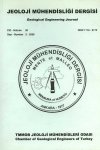
ABSTRACT: Caliche is a general term that describes a secondary carbonate accumulation in unconsolidated sediments, sedimentary rocks and soils under semi-arid and arid climate conditions. Caliches are composed dominantly of small calcite crystals in micrite (< 4 m) and microsparite (5-15 m) size. Small amount of diagenetic minerals such as sepiolite, palygorskite, magnesium calcite and dolomite etc. are associated with calcium carbonate (low Mg-calcite) occurrences. Caliche appears in a variety of forms such as chalky powdery, nodular, tubular, laminated crust, hardpan (indurated crust). In caliche, macroscopic rhizolithic structures and microscopic alfa and beta fabric constituents are common. Two main hypotheses which explain the origin of caliche. These are; (a) downward movement of dissolved CaCO3 (per descensum; pedogenetic); and (b) capillary rise from groundwater (per ascensum; groundwater) models. During calicheformation, calcium is providedfrom varied sources.
ABSTRACT: Karren observed in the area to the east of Kızılörü Mountain located in the northwest of Antalya has been formed on Jurassic-Cretaceous (Cenomanian) neritic limestones, In order to show the relationship of karren with the structural features, the main development directions of karren and the deviations of fracturesfrom the north have been measured in thefield and the data obtained have been evaluated by transferring them in to rose diagrams. In the rose diagrams prepared, between the dominant direction of circular karren and orientation ofp rimary and secondary fractures in the NE-SW directions a great harmony was observed. The relations between the primary and secondary dominant directions of the hydrodynamically controlled linear karren and dominant fracture orientations were significantly weak. Solutions pits and solutions pans are in larger scalefracture controlled while rillenkarren and rinnenkarren have a hydrodynamically controlled formation and development mechanism
ABSTRACT: Increase in bottled water consumption in our country has been observed especially in last decade as in developed countries. A lot off irms have materialized the bottled water production particularly in the industrialized and overpopulated areas in Turkey with the high consumption of the bottled water. The number of bottled water production firm is over 180 in Turkey atp resent. In this study, physical and chemicalparameters oft he bottled waters have been evaluated according to the statistical characteristics. Physical and chemical parameters in the bottled water which are sometimes over the limits can negatively affect the human health. Median values oft he bottled waters` chemical parameters have been compared with the limit values designated by The Ministry of Health and interpretations of the over limit parameters have been realized. On the other hand, concentrations of calcium (Ca), magnesium and sodium (Na) ions, which are present in the major amounts in the bottled water and necessary for the human body, evaluated statistically and interpretedfrom the point of health. Ca, Mg and Na contents of the bottled and tap waters in Turkey have been compared with Europe and North America`s bottled and tap waters. This comparison has showed that these three minerals contents ofo ur bottled waters are poorer but, tap waters are richer than Europe and North America`s. It is understood that recommended daily intake amount of Ca (800 mg/day) and Mg (350 mg/day) for the body can be obtained by the consumption of2 liters per dayfrom the bottled, tap and mineral water in Turkey in the range of2.5% Ca, 8.8% Ca, 35% Caand 1.4 %Mg, 7.5%Mg, 33%Mg, respectively.
ABSTRACT: Petroleum hydrocarbons are used to meet a big portion of energy demand that is needed to sustain the human life. Accidental release and leakage of petroleum hydrocarbons may cause groundwater contamination and can have extremely serious consequences from both human and environmental health perspectives. Basically, petroleum hydrocarbons can be divided in two major groups. First group is called light non-aqueous phase liquids which float on water. Second group of petroleum hydrocarbons is called dense non-aqueous phase liquids and they are denser than water. Contaminations caused by light non-aqueous phase liquids can be relatively more easily remediated when compared to dense non-aqueous phase liquids and contaminations caused by dense non-aqueous phase liquids generally require application of more complex remediation technologies. There are different methods exist for the remediation of petroleum hydrocarbon contamination in the saturated and unsaturated zones ofthe aquifers. Among these, most frequently used ones are; gas/air injection, soil vapor/gas extraction, directional wells,in-well aeration, dual phase extraction, chemical oxidation, thermal treatment, fracturing enhancement and permeable reactive barrier technologies. Before the application of any method, the most important thing to do is to define aquifer and contaminant characteristics and spatial extent of the contaminant for an effective treatment process. Each one of these methods has several advantages and disadvantages that are resulted directly from properties of the contaminated aquifers. For this reason, in the petroleum hydrocarbon contaminated aquifers generally not a single method is used but a combination of two or more methods are appliedfor a more effective treatment.

 TMMOB
TMMOB